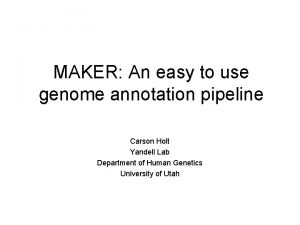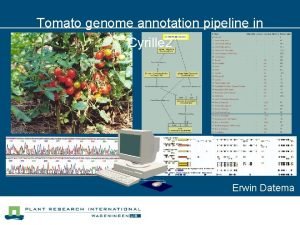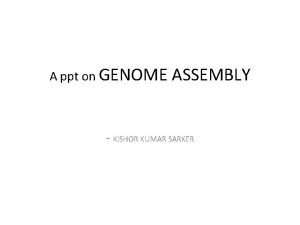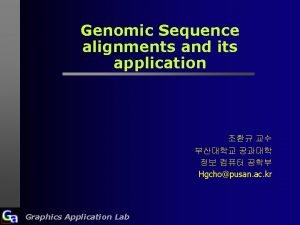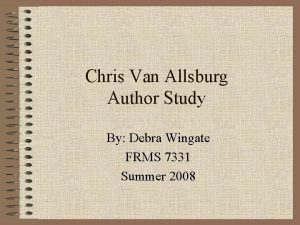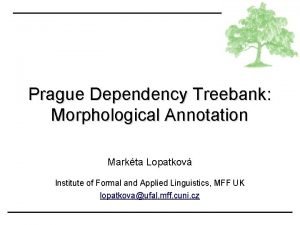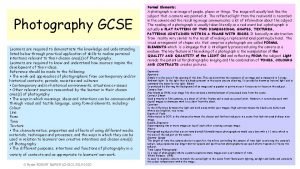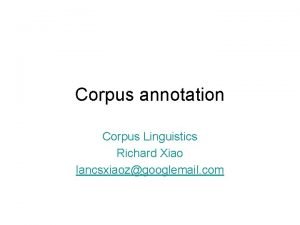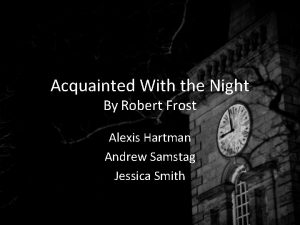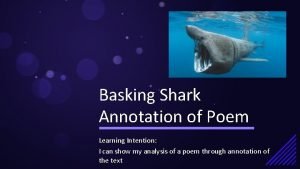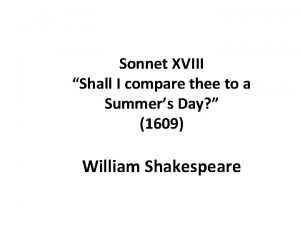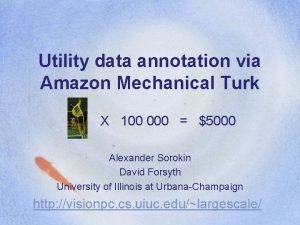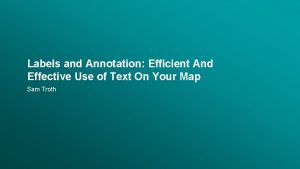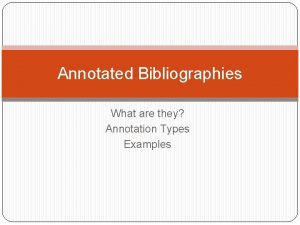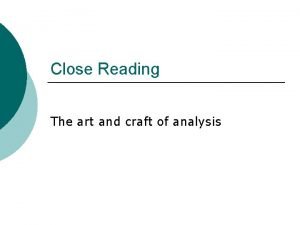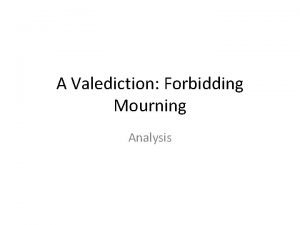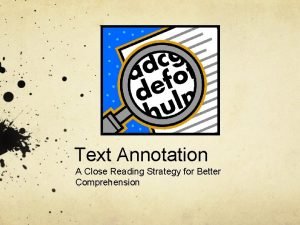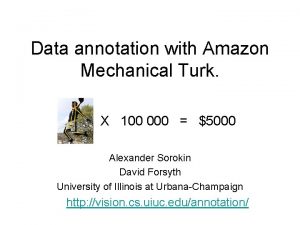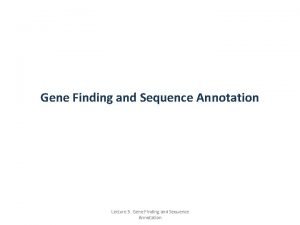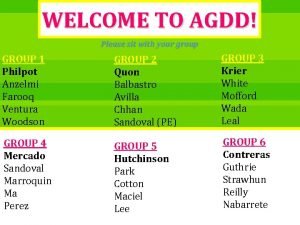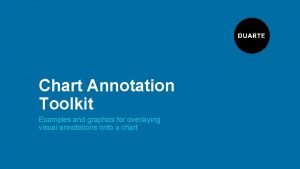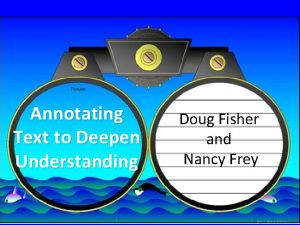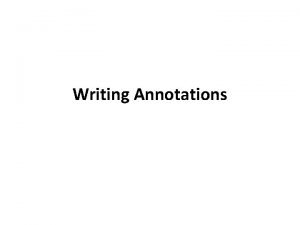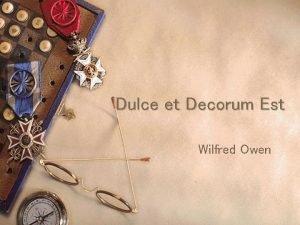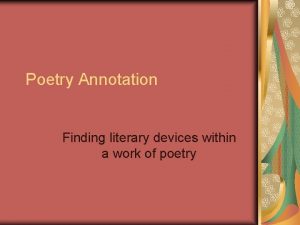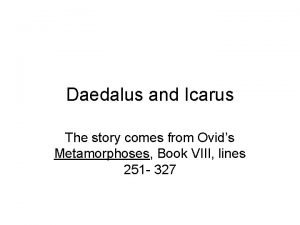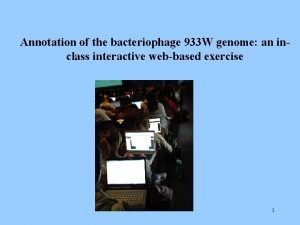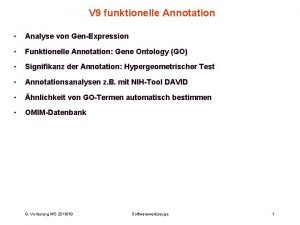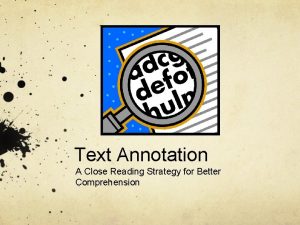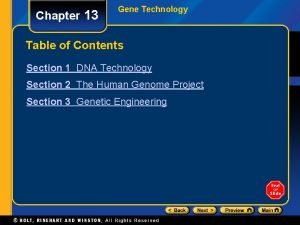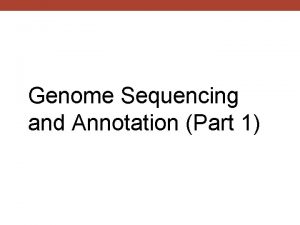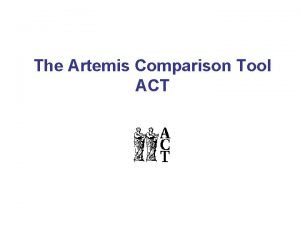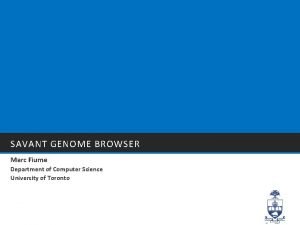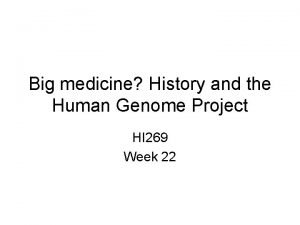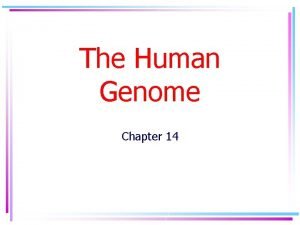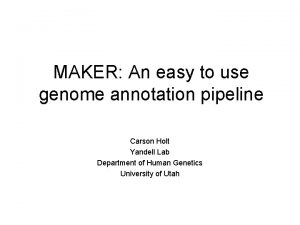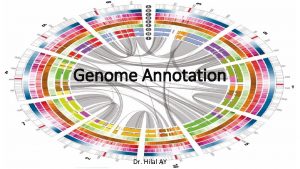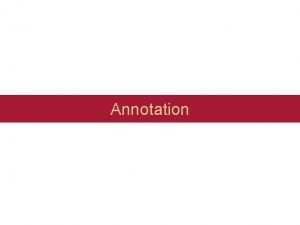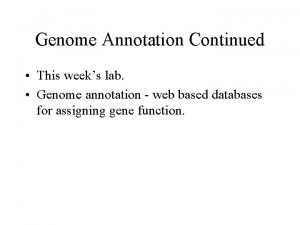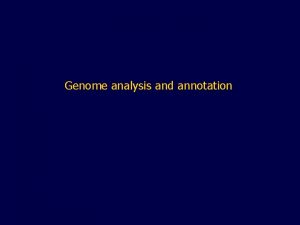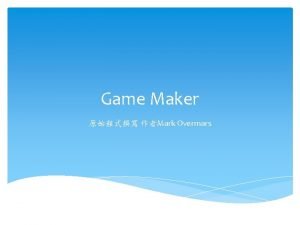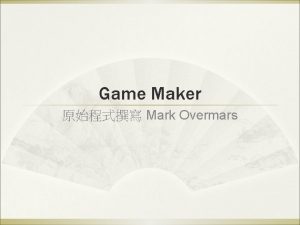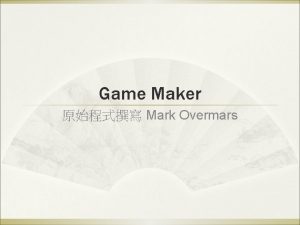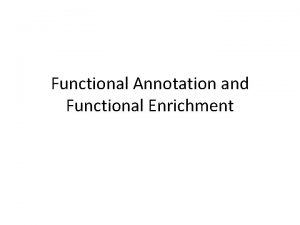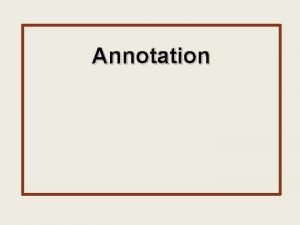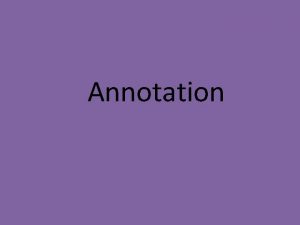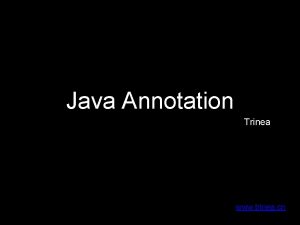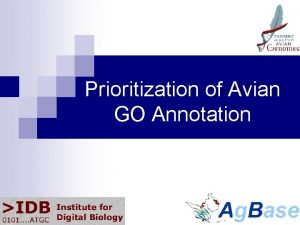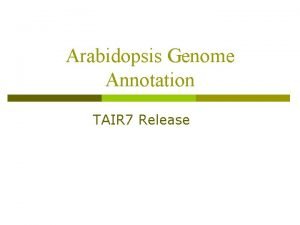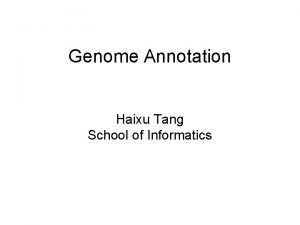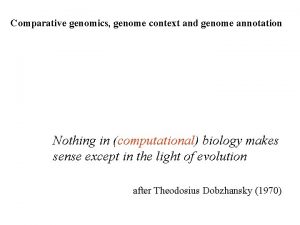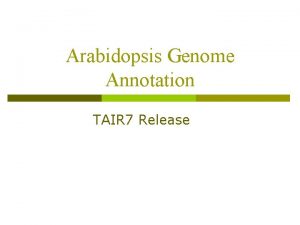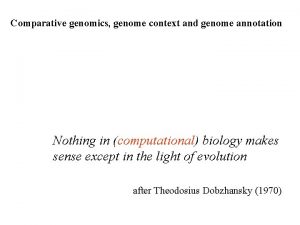MAKER An easy to use genome annotation pipeline
























































![Working with Chado • • maker 2 chado [OPTION] <database_name> <gff 3 file 1> Working with Chado • • maker 2 chado [OPTION] <database_name> <gff 3 file 1>](https://slidetodoc.com/presentation_image/13e437f37021e34830ddb0892c1da2e0/image-57.jpg)
![Working with JBrowse • maker 2 jbrowse [OPTION] <gff 3 file 1> <gff 3 Working with JBrowse • maker 2 jbrowse [OPTION] <gff 3 file 1> <gff 3](https://slidetodoc.com/presentation_image/13e437f37021e34830ddb0892c1da2e0/image-58.jpg)
- Slides: 58

MAKER: An easy to use genome annotation pipeline Carson Holt Yandell Lab Department of Human Genetics University of Utah

Introduction to Genome Annotation • What annotations are • Importance of genome annotations • Effect of next generation sequencing technologies on the annotation process

What Are Annotations? • Annotations are descriptions of features of the genome – Structural: exons, introns, UTRs, splice forms etc. – Functional: metabolism, hydrolase, expressed in the mitochondria, etc. • Annotations should include evidence trail – Assists in quality control of genome annotations • Examples of evidence supporting a structural annotation: – Ab initio gene predictions – ESTs – Protein homology

Background Why should I care about genome annotations? SUCCESS >Smg 5 MEVTFSSGGSSNASSECAIDGGTNR CRGLEPNNGTCILSQEVKDLYRSLYT ASKQLDDAKRNVQSVGQLFQHEIEEK RSLLVQLCKQIIFKDYQSVGKKVREV MWRRGYYEFIAFV

Background Why should I care about genome annotations? Incorrect annotations poison every experiment that uses them!! SUCCESS >Smg 5 MEVTFSSGGSSNASSECAIDGGTNR CRGLEPNNGTCILSQEVKDLYRSLYT ASKQLDDAKRNVQSVGQLFQHEIEEK RSLLVQLCKQIIFKDYQSVGKKVREV MWRRGYYEFIAFV

Advances in Technology Promise to Make Whole Genome Sequencing “Routine” for Even Small Labs

Advances in annotation technology have not kept pace with genome sequencing, and annotation is rapidly becoming a major bottleneck affecting modern genomics research. • • As of October 2009, 222 eukaryotic genomes were fully sequenced yet unpublished. Currently there are over ~900 eukaryotic genome projects underway, assuming 10, 000 genes per genome, that’s 9, 000 new annotations. There is a limit to how much data can be managed, maintained, and updated by a single organization. Small research groups affected disproportionately by difficulties related to genome annotation. • . GOLD: Genomes On. Line Database. 2009.

• MAKER is an easy-to-use annotation pipeline designed to help smaller research groups convert the mountain of genomic data provided by next generation sequencing technologies into a usable resource.

MAKER Overview • What does MAKER do? • What sets MAKER apart from other tools (ab initio gene predictors, etc. )?

MAKER • The easy-to-use annotation pipeline. MAKER identifies repeats, aligns ESTs and proteins to a genome, produces ab-initio gene predictions, automatically synthesizes these data into gene annotations, and produces evidence-based quality values for downstream annotation management § § Lewis, S. E. et al. Apollo: a sequence annotation editor. Genome Biology 3, research 0082. 1 - 0082. 14 (2002). Stein, L. D. et al. The Generic Genome Browser: A Building Block for a Model Organism System Database. Genome Res. 12, 1599 -1610 (2002).

Other Features

MPI Support • Message Passing Interface (MPI) is a communication protocol for computer clusters which essentially allows multiple computers to act like a single powerful machine.

MPI Maker

What sets MAKER apart from other tool (i. e. ab initio gene predictors)? Computational evidence Gene-predictions Gene annotation gene prediction ≠ gene annotation

Model versus Emerging genomes Model genomes: • Classic experimental systems • Much prior knowledge about genome • Large community • Big $ Examples: D. melanogaster, C. elegans, human, etc

Model versus Emerging genomes: • New experimental systems • Little prior knowledge about genome • Small communities – Genome will be the central resource for work in these systems – Usually no genetics • Less $ Examples: flatworms, oomycetes, the cone snail, etc.

Comparison of gene models produced by state-of-the art algorithms against a REFERENCE genome MAKER: An easy-to-use annotation pipeline designed for emerging model organism genomes. (2008)Cantarel B L, Korf I, Robb SM, Parra G, Ross E, Moore B, Holt C, Sanchez Alvarado A, Yandell M Genome Res 18(1) 188 -196

Comparison of gene models produced by state-of-the art algorithms against a REFERENCE genome With enough training data, ab-initio gene predictors can match or even out-perform annotation pipelines* *n. GASP - the nematode genome annotation assessment project Avril Coghlan , Tristan J Fiedler , Sheldon J Mc. Kay , Paul Flicek , Todd W Harris , Darin Blasiar , The n. GASP Consortium and Lincoln D Stein BMC Bioinformatics 2008, 9: 549 doi: 10. 1186/1471 -2105 -9 -549

Ab initio gene predictors don’t do nearly so well on emerging genomes* Average of seven REFERENCE proteomes S. mediterranea SNAP ab-initio gene predictions 35% contain a domain 7% contain a domain MAKER S. mediterranea annotations 29% contain a domain *MAKER: An easy-to-use annotation pipeline designed for emerging model organism genomes. (2008)Cantarel B L, Korf I, Robb SM, Parra G, Ross E, Moore B, Holt C, Sanchez Alvarado A, Yandell M Genome Res 18(1) 188 -196

Benefits of MAKER • Provides gene models as well as an evidence trail correlations for quality control and manual curation • Provides a mechanism to train and retrain ab initio gene predictors for even better performance. • Output can be loaded into a GMOD compatible database for annotation distribution • Annotations can be automatically updated by new evidence by simply passing existing annotation sets back into the pipeline

What is Happening Inside MAKER • • • Repeat. Masking Ab Initio Gene Prediction EST and Protein Evidence Alignment Polishing Evidence Alignments Integrating Evidence to Synthesize Final Annotations

Annotating the Genome – Apollo View Current evidence Current Assembly

Identify and Mask Repetitive Elements Current evidence Current Assembly

Identify and Mask Repetitive Elements • Repeat. Masker – Rep. Base – Species specific. Current library evidence • Repeat. Runner – MAKER internal protein library Current Assembly

Identify and Mask Repetitive Elements Current evidence Current Assembly

Generate Ab Initio Gene Predictions Current evidence Ab initio Predictions Current Assembly

Generate Ab Initio Gene Predictions • MAKER currently supports: – – SNAP Augustus Gene. Mark FGENESH Current evidence Ab initio Predictions • Remember to supply HMM’s for each Current Assembly

Generate Ab Initio Gene Predictions Current evidence Ab initio Predictions Current Assembly

Align EST and Protein Evidence EST TBLASTX Protein BLASTX EST BLASTN Current evidence Ab initio Predictions Current Assembly

Align EST and Protein Evidence • Identify EST regions being actively TBLASTX transcribed. Protein (i. e. BLASTX EST data) EST BLASTN • Identify region with homology to a Current evidence known protein Ab initio Predictions Current Assembly

Align EST and Protein Evidence EST TBLASTX Protein BLASTX EST BLASTN Current evidence Ab initio Predictions Current Assembly

Polish BLAST Alignments with Exonerate Polished protein Current evidence Polished EST Ab initio Predictions Current Assembly

Polish BLAST Alignments with Exonerate • All base pairs must aligns in order. • No HSP overlap is permitted Current evidence Polished protein Polished EST • Aligns HSPs correctly with respect Ab initio Predictions to splice sites. Current Assembly

Polish BLAST Alignments with Exonerate Polished protein Current evidence Polished EST Ab initio Predictions Current Assembly

Pass Gene Finders Evidence-based ‘hints’ Current evidence Ab initio Predictions Hint-based SNAP Hint-based Fgenes. H Current Assembly

Identify Gene Model Most Consistent with Evidence* Current evidence * Ab initio Predictions Hint-based SNAP Hint-based Fgenes. H Current Assembly *Quantitative Measures for the Management and Comparison of Annotated Genomes Karen Eilbeck , Barry Moore , Carson Holt and Mark Yandell BMC Bioinformatics 2009 10: 67 doi: 10. 1186/1471 -2105 -10 -67

Revise it further if necessary; Create New Annotation Current evidence * Ab initio Predictions Current Assembly

Compute Support for Each Portion of Gene Model

Using MAKER

MAKER Web Annotation Service

MAKER Web Annotation Service

http: //www. yandell-lab. org

De novo Annotation of a Newly Sequenced Genome • You are involved in a genome project for an emerging model organism. • You have no pre-existing gene models. • What you do have: – ESTs – Proteins from other species available from public databases

Go to Web

GFF 3 pass-through: How to use external evidence • You have an existing annotation set. • You want to update the evidence and allow the annotation to change to reflect the new evidence.

What if I have m. RNA-seq data?

RNA-seq is fundamentally changing the field of genome annotation for both model and emerging genomes

RNA-seq may soon make gene prediction (mostly) a thing of the past • Still need to de-convolute reads & evidence (for now) • Still need to archive and distribute annotations • Still need to manage genome and its annotations

How to use RNA-seq data in MAKER • Use Bow. Tie and Top. Hat to produce, aligns reads into expression “islands” and “junctions” • Pass data through as EST evidence via GFF 3 pass-through.

Go to Web

Another issue: legacy annotations • Many are no longer maintained by original creators • In some cases more than one group has annotated the same genome, using very different procedures, even different assemblies • The communities associated with those genomes are going to want m. RNA-seq data • Many investigators have their own genome-scale data and would like a private set of annotations that reflect these data • There will be a need to revise, merge, evaluate, and verify legacy annotation sets in light of RNA-seq and other data

Merging and Revising Legacy Annotation Sets Legacy Annotation Set 1 Legacy Annotation Set 2 Legacy Annotation Set n new data current assembly • Identify legacy annotation most consistent with new data • Automatically revise it in light of new data • If no existing annotation, create new one

Align Evidence and Legacy Annotations to Current Assembly Current evidence Legacy Annotations Current Assembly

Pass Gene Finders Evidence-based ‘hints’ Current evidence Legacy Annotations Hint-based SNAP Hint-based Fgenes. H Current Assembly

Identify Gene Model Most Consistent with Evidence* Current evidence * Legacy Annotations Hint-based SNAP Hint-based Fgenes. H Current Assembly *Quantitative Measures for the Management and Comparison of Annotated Genomes Karen Eilbeck , Barry Moore , Carson Holt and Mark Yandell BMC Bioinformatics 2009 10: 67 doi: 10. 1186/1471 -2105 -10 -67

Go to Web
![Working with Chado maker 2 chado OPTION databasename gff 3 file 1 Working with Chado • • maker 2 chado [OPTION] <database_name> <gff 3 file 1>](https://slidetodoc.com/presentation_image/13e437f37021e34830ddb0892c1da2e0/image-57.jpg)
Working with Chado • • maker 2 chado [OPTION] <database_name> <gff 3 file 1> <gff 3 file 2>. . . maker 2 chado [OPTION] -d <datastore_index> <database_name> This script takes MAKER produced GFF 3 files and dumps them into a CHADO database. You must set the database up first according to CHADO installation instructions. CHADO provides its own methods for loading GFF 3, but this script makes it easier for MAKER specific data. You can either provide the datastore index file produced by MAKER to the script or add the GFF 3 files as command line arguments.
![Working with JBrowse maker 2 jbrowse OPTION gff 3 file 1 gff 3 Working with JBrowse • maker 2 jbrowse [OPTION] <gff 3 file 1> <gff 3](https://slidetodoc.com/presentation_image/13e437f37021e34830ddb0892c1da2e0/image-58.jpg)
Working with JBrowse • maker 2 jbrowse [OPTION] <gff 3 file 1> <gff 3 file 2>. . . • maker 2 jbrowse [OPTION] -d <datastore_index> This script takes MAKER produced GFF 3 files and dumps them into JBrowse for you using preconfigured JSON tracks.
 Maker annotation tutorial
Maker annotation tutorial Tomato genome browser
Tomato genome browser Genome assembly ppt
Genome assembly ppt Semi-global alignment
Semi-global alignment Windows live movie maker
Windows live movie maker Linear pipelining
Linear pipelining Scalar pipeline vs vector pipeline
Scalar pipeline vs vector pipeline Examples of deductive reasoning
Examples of deductive reasoning Deductive v inductive reasoning
Deductive v inductive reasoning Inductive vs deductive
Inductive vs deductive Zathura annotation
Zathura annotation Morphological annotation
Morphological annotation Gcse photography annotation
Gcse photography annotation Richard xiao
Richard xiao David functional annotation
David functional annotation Acquainted with the night literary devices
Acquainted with the night literary devices Braker annotation
Braker annotation Basking shark poem annotated
Basking shark poem annotated The two terms of comparison in the first two quatrains are
The two terms of comparison in the first two quatrains are Amazon data annotation
Amazon data annotation Convert labels to annotation
Convert labels to annotation Annotation examples
Annotation examples Critical annotation
Critical annotation Eclipse annotation processor
Eclipse annotation processor Valiant cousin
Valiant cousin The santa ana winds joan didion annotation
The santa ana winds joan didion annotation Annotation slows down the reader to deepen understanding
Annotation slows down the reader to deepen understanding Valediction calamity
Valediction calamity Types of holes
Types of holes Benjamin banneker letter to thomas jefferson annotation
Benjamin banneker letter to thomas jefferson annotation Robert frost gold
Robert frost gold Text symbols for annotating text
Text symbols for annotating text Amazon data annotation
Amazon data annotation Gene finding
Gene finding Annotation guide
Annotation guide Catch annotations
Catch annotations Gcse art annotation format
Gcse art annotation format Annotation toolkit
Annotation toolkit Acquainted with the night annotation
Acquainted with the night annotation Annotation slows down the reader to deepen understanding
Annotation slows down the reader to deepen understanding What is annotation
What is annotation Dulce et decorum est annotation
Dulce et decorum est annotation The most dangerous game summary
The most dangerous game summary Annotating a poem
Annotating a poem Landscape with the fall of icarus annotation
Landscape with the fall of icarus annotation Patricia pogson yesterday
Patricia pogson yesterday Bacteriophage annotation
Bacteriophage annotation Theme of o captain my captain
Theme of o captain my captain David go annotation
David go annotation Annotate poem generator
Annotate poem generator Annotating reading strategies
Annotating reading strategies American law reports annotation
American law reports annotation Living space poem
Living space poem Chapter 13 section 3 the human genome
Chapter 13 section 3 the human genome Hierarchical shotgun sequencing vs whole genome
Hierarchical shotgun sequencing vs whole genome Artemis comparison tool
Artemis comparison tool Savant genome browser
Savant genome browser Human genome project
Human genome project Chapter 14 the human genome making karyotypes answer key
Chapter 14 the human genome making karyotypes answer key
